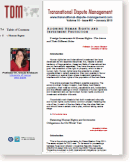With this work written in English (click here to access the document), Professor Zamora Cabot continues his already wide and prolific research on the Alien Tort Claims Act (hereinafter, ATCA) of the United States, and on its application. In this paper the author focuses on a decisive issue: the question of extraterritoriality that is being discussed in the Kiobel case. The author declares that the way this question is being presented -i.e., whether the United States is exceeding its competences vis-á-vis public international law from the point of view of extraterritoriality, related to imposition or legal imperialism- is completely wrong. The United States is not acting against the Law of Nations and the debate on this issue is actually unfounded. To support his opinion, after some previous considerations in the introductory Part of this work, Professor Zamora Cabot brings up several cases sustaining the aforementioned negative. Most specifically, in Section II, and just as an aide-mémoire, the author highlights three milestones in the field of international economic sanctions: Section 301 et seq. of the United States Trade Act of 1974 and its application, the Siberian Gas Pipeline case and the renowned Cuban Embargo case which comprises some important elements, such as the Helms-Burton Act. In his opinion, based on a long personal research, the opponents to the ATCA are trying to place it into a controversial and troubled field, taking advantage of the negative memory sparked off by the real conflicts of extraterritoriality, as exemplified by the U.S. international sanctions regime.
In Section III, the author, in line with the original interpretation made by the United States Court of Appeals for the Second Circuit in its seminal case Filártiga, argues that the cases on the application of the ATCA are based on special torts, for which the mechanics and approaches of Private international law do play a significant role. Evaluating the set of jurisdictional and legislative competences (jurisdiction to adjudicate and jurisdiction to prescribe) of the United States confronted with the Law of Nations, and regarding its practice, the author declares that those competences can be exercised without problems, just as the United States courts are repeatedly reflecting in their jurisprudence while deciding other kinds of international tort cases. This does not imply denying the special features of the ATCA cases, mainly defined by two facts: first, the need of contrasting the consistency with the Jus Cogens of the conducts underlying these cases,to confirm if the reservation of jurisdiction to adjudicate in favor of the federal courts as dictated by the ATCA is justified; second, the possibility for the federal courts to base their decisions on federal common law, to the extent that it has integrated the mandates of Public international law.But it is worth noting, in any case, that these special torts do not lead to exclusion, but to the opportunity to make Private international law and Public international law to cooperate, which always ennobles both of them.
Finally, in Section IV, Professor Zamora Cabot concludes his research with this idea: if the United States Supreme Court decides in the Kiobel case against the brilliant jurisprudence generated by the ATCA in that country, which is in favor of the Human Rights and which constitutes a magnificent example for the international community, the fight to protect them will continue. And it will do so before the State Courts inside the United States, as well as before many other courts across the length and breadth of the globe. Actually, the international community is becoming more sensitive and mindful, and numerous initiatives are being taken, especially regarding cases based on human rights violations committed by multinational corporations.
